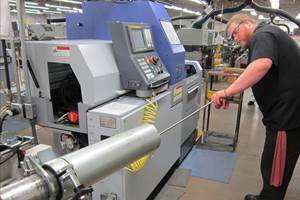Three Reasons Why Mechanical Properties of Cold-Drawn Steel Can Vary
Why do the mechanical properties on different shipments of the same size and grade of steel vary so much?
Why do the mechanical properties on different shipments of the same size and grade of steel vary so much?
To answer this, lets look at Grade 1018, a non-free machining grade that we may encounter in our shops.
We’ll pull it until it’s two pieces.
A cold-drawn, 1018 steel bar of 1-inch diameter typically has a tensile strength (TS) of 64,000 psi; yield strength (YS) of 54,000 psi; percent Elongation in 2-inch (%EL) of 15 percent; and percent Reduction of Area (%RA) of 40 percent. (According to Information Report SAE J 1397, Estimated Mechanical Properties and Machinability of Steel Bars.) Note that these are estimated values, not minimums.
Your mileage (properties) may vary. Here are three reasons why:
1. The original melt and cast process can affect chemical makeup. Basic Oxygen Furnace (BOF) steels are made from a high percentage of new metal and thus have lower levels of residual elements from scrap that could strengthen the material. Also, BOF steels tend to run lower levels of nitrogen, which is a ferrite strengthener. So, BOF Melt steels tend to be on the low side of mechanical properties like tensile and yield, and a bit higher ductility (%RA and %EL in 2-inch).
2. The mechanical properties of cold-drawn steel are affected by the amount of cold work. This can come about in two different ways. The first way is as the bar size ordered gets smaller, given a standard draft, the percentage of cold work increases. This increase in the percentage of cold work increases the mechanical properties of tensile and yield strength and can decrease the ductility somewhat.
The second way can be when different vendors use a different “drafting practice” resulting in a different amount of cold work to make the same size. Typical draft may be to use hot-roll sized 1/16-inch over the final size for drawing. Another vendor may choose 3/32-inch oversize. And, in rare cases, a company might use 1/8-inch to assure exceeding, not just meeting, minimum yield strength.
3. The final steps of straightening and polishing can relax the steel. The amount of cold work done in straightening the bars can relax the steel because the force is applied transverse to the original drawing. So, a supplier using a two-roll straightener, all other things being equal, might produce bars with a different final set of properties than one using a train of planishing discs to get the bar commercially straight.
So what values could you expect to encounter in Grade 1018 steel when looking at all of these effects? We’ve seen 3/8-inch 1018 with tensile strength in the high 80,000s; yield strength in the high 70,000s; %EL in 2-inch as high as 26; and %RA as high as 65.
In 4-inch Grade 1018, we’ve seen TS as low as 58,000 psi; YS of about 42,000 psi; %EL in 2-inch of 12 percent; and %RA of 35 percent.
The process path generally can explain the properties received. It also explains why those mechanical properties you receive are sometimes so far from what you expect.
Related Content
Metalworking Fluid Management and Best Practices
Cutting metal is a complex process involving many critical factors to be successful. Correctly applied metalworking fluids, including oils or coolant, is one of these critical factors.
Read MoreImportant Machining Factors of Carbon Steels
Learn the factors that contribute to carbon steels and their machinability as well as the 1214 steels, 1215 steels and 1018 steels, other grades, and more.
Read More6 Tips for Training on a Swiss-Type Lathe
There are nuances to training a person to effectively operate a Swiss-type lathe. A shop I visited a while back offers some suggestions.
Read MoreCraftsman Cribsheet No. 128: Why Do Machinists Say Tenths Instead of Ten Thousandths?
In machinist parlance, a tenth is a tenth of a thousandth, not a tenth of an inch.
Read MoreRead Next
Do You Have Single Points of Failure?
Plans need to be in place before a catastrophic event occurs.
Read MoreA Tooling Workshop Worth a Visit
Marubeni Citizen-Cincom’s tooling and accessory workshop offers a chance to learn more about ancillary devices that can boost machining efficiency and capability.
Read More5 Aspects of PMTS I Appreciate
The three-day edition of the 2025 Precision Machining Technology Show kicks off at the start of April. I’ll be there, and here are some reasons why.
Read More





















